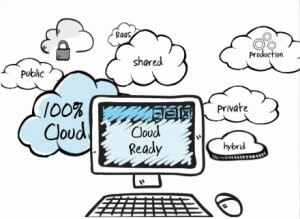Here is a quick guide for developing an IT strategy for Cloud Computing.
Today, the question is not whether your organization will adopt Cloud Computing or not but when. Such is the prominence with almost 75% of even the small businesses either already into or getting ready to enter the cloud In case you really aren’t so sure about deploying your resources into the cloud, then here are 10 common questions that will help to identify and therefore define the correct Cloud Computing strategy for your organization.
1. What is Cloud Computing ?
It is the virtual distribution of shares that the end user uses as a service. There is talk of cloud in two contexts: (1) what type of cloud is built and (2) how to use it. IT professionals tend to think in terms of cloud infrastructure (Eg: public, private or hybrid cloud). Business decision makers can focus more on the type of service to be distributed: Infrastructure-as-a-Service (IaaS) and Platform-as-a-Service (SaaS). Align the two perspectives help to articulate a great cloud.
2. Why should your organization implement Cloud ?
The cloud can help to manage the pressures faced by IT organizations to cut costs, respond rapidly to requests, and ensure data security and compliance. These pressures can be reduced by adopting the cloud as it exhibits better use of resources and services on demand and also better security management policies.
3. What should be your first step in planning the strategy?
You could start by developing a strategic document that includes:
- A broad description of the business case.
- Implementing steps defined
- The definition of cloud architecture
- The plan’s / client computers
- Plan monitoring and management
- Plan Association business and IT
4. How do you ensure that your Cloud strategy is complete?
Document how it will impact the business processes on migration from a model that uses applications in virtual machine (VM) to a cloud model. Consider categorization of workloads based on various infrastructure needs.
Standard : productivity applications and non-core work loads or applications that are used daily.
Strategic : applications and core workloads that create value and differentiate the business.
Pilot : applications and workloads that drive innovation and create new opportunities for business.
5. What is the right delivery model service for your organization?
The best is the one that fits their workloads to environments to provide the services your end user needs. To determine the correct model consider the factors that are specific to your data center and its organization (eg: type of workload demand, scale, security requirements and service level expectations).
6. Is “virtualization” similar to that of “cloud”?
Virtualization abstracts computing resources-usually as VMS (Virtual Memory System) – connectivity and associated storage capacity. The cloud determines how to assign, deliver and present these virtualized resources. While not required virtualization to cloud “bare metal” (or cloud with dedicated hardware), cloud-based virtualization allows you to scale resources more quickly in a way that in non-virtualized environments is difficult.
7. How to implement a secure infrastructure?
Find an architecture that is reliable and remember these principles:
- Secure residence: understand where the data is stored and how to access them.
- Secure the movement: understand the networks through which data are disseminated.
- Secure method: understand how data is transmitted through the networks storages.
8. How do you evaluate the current status and map to follow your strategy for Cloud ?
Are you running an application on a server or virtualized their servers to improve efficiency? Both solutions work, but can impede innovation or limit scalability. To take the next step, outlining this vision for service delivery and compare to three constraints: service agreements, the budget and the optimal use of servers.
9. How can the cloud affect current business practices?
Change of manually provisioning to an automatic infrastructure.
Evolve to support static to dynamic services. Adopt the principles of “DevOps”. Let it act as an intermediary services, promoting the business rather than just support it.
10. Are there terms and concepts related to cloud you should know about?
Expansion cloud ( Cloud bursting): an application running in a private cloud or in a data center and “expanded” into a public cloud with increasing demand for computing power.
Virtualization network function (NFV): virtualize entire classes of functions node network building blocks that can be connected or chained together to create communication services.
Software Defined Network (SDN): Allows administrators to manage networks and provide network services through automation and software defined networks.
Storage defined by software (SDS): A storage environment defined by software, that can scale massively. Levels and provides automated data and media management in high-volume servers.
Software Defined Infrastructure (SDI, for its acronym in English): allows an environment in which applications systems defined by sets of resource management, service assurance and provisioning.
Have you already applied these technologies in your business? Tell us about your experience.


